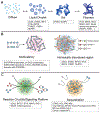Liquid-liquid phase separation in innate immunity
- PMID: 38762334
- PMCID: PMC11247960
- DOI: 10.1016/j.it.2024.04.009
Liquid-liquid phase separation in innate immunity
Abstract
Intrinsic and innate immune responses are essential lines of defense in the body's constant surveillance of pathogens. The discovery of liquid-liquid phase separation (LLPS) as a key regulator of this primal response to infection brings an updated perspective to our understanding of cellular defense mechanisms. Here, we review the emerging multifaceted role of LLPS in diverse aspects of mammalian innate immunity, including DNA and RNA sensing and inflammasome activity. We discuss the intricate regulation of LLPS by post-translational modifications (PTMs), and the subversive tactics used by viruses to antagonize LLPS. This Review, therefore, underscores the significance of LLPS as a regulatory node that offers rapid and plastic control over host immune signaling, representing a promising target for future therapeutic strategies.
Keywords: DNA sensing; LLPS; PTMs; RNA sensing; immune signaling; innate immunity; membraneless organelles; phase separation; post-translational modification; proteomics; viral infection.
Copyright © 2024 Elsevier Ltd. All rights reserved.
Conflict of interest statement
Declaration of interests The authors declare that they have no competing interests.
Figures


Similar articles
-
An artificial intelligence-based approach for identifying the proteins regulating liquid-liquid phase separation.Brief Bioinform. 2025 Jul 2;26(4):bbaf313. doi: 10.1093/bib/bbaf313. Brief Bioinform. 2025. PMID: 40632496 Free PMC article.
-
Interplay between posttranslational modifications and liquid‒liquid phase separation in tumors.Cancer Lett. 2024 Mar 1;584:216614. doi: 10.1016/j.canlet.2024.216614. Epub 2024 Jan 19. Cancer Lett. 2024. PMID: 38246226 Review.
-
Liquid-liquid phase separation: an emerging perspective on the tumorigenesis, progression, and treatment of tumors.Front Immunol. 2025 Jun 26;16:1604015. doi: 10.3389/fimmu.2025.1604015. eCollection 2025. Front Immunol. 2025. PMID: 40642070 Free PMC article. Review.
-
ATP as a Key Modulator of Fused-in-sarcoma Phase Separation and Aggregation: Insights into Amyotrophic Lateral Sclerosis Pathogenesis.J Mol Biol. 2025 Sep 1;437(17):169295. doi: 10.1016/j.jmb.2025.169295. Epub 2025 Jun 16. J Mol Biol. 2025. PMID: 40516596
-
The Human Papillomavirus E6 Oncoprotein Targets USP15 and TRIM25 To Suppress RIG-I-Mediated Innate Immune Signaling.J Virol. 2018 Feb 26;92(6):e01737-17. doi: 10.1128/JVI.01737-17. Print 2018 Mar 15. J Virol. 2018. PMID: 29263274 Free PMC article.
Cited by
-
Molecular Mechanisms and Potential Antiviral Strategies of Liquid-Liquid Phase Separation during Coronavirus Infection.Biomolecules. 2024 Jun 24;14(7):748. doi: 10.3390/biom14070748. Biomolecules. 2024. PMID: 39062463 Free PMC article. Review.
-
Liquid-liquid separation in gut immunity.Front Immunol. 2024 Dec 10;15:1505123. doi: 10.3389/fimmu.2024.1505123. eCollection 2024. Front Immunol. 2024. PMID: 39720729 Free PMC article. Review.
-
Evolutionary analysis of ZAP and its cofactors identifies intrinsically disordered regions as central elements in host-pathogen interactions.Comput Struct Biotechnol J. 2024 Aug 2;23:3143-3154. doi: 10.1016/j.csbj.2024.07.022. eCollection 2024 Dec. Comput Struct Biotechnol J. 2024. PMID: 39234301 Free PMC article.
-
Gut microbiome and inflammation in cardiovascular drug response: trends in therapeutic success and commercial focus.Inflammopharmacology. 2025 Jan;33(1):49-68. doi: 10.1007/s10787-024-01593-x. Epub 2024 Nov 2. Inflammopharmacology. 2025. PMID: 39488611 Review.
-
Thiostrepton: multifaceted biological activities and its applications in treatment of inflammatory diseases.Inflammopharmacology. 2025 Jan;33(1):183-194. doi: 10.1007/s10787-024-01587-9. Epub 2024 Nov 2. Inflammopharmacology. 2025. PMID: 39487942 Review.
References
-
- Shin Y. and Brangwynne CP (2017) Liquid phase condensation in cell physiology and disease. Science 357(6357):eaaf4382. - PubMed
Publication types
MeSH terms
Substances
Grants and funding
LinkOut - more resources
Full Text Sources
Miscellaneous

